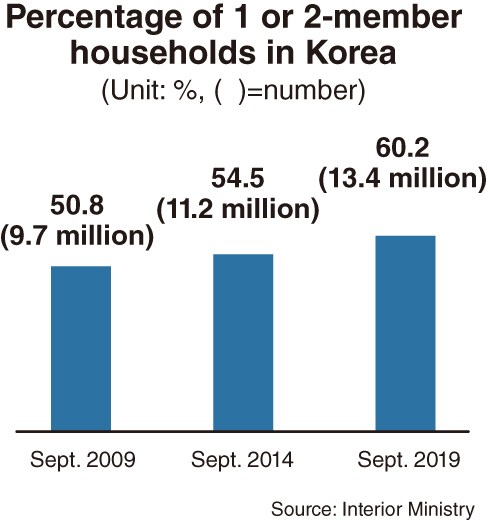[News Focus] 60% of Korean households have 1-2 members
By Kim Yon-sePublished : Oct. 15, 2019 - 16:59
SEJONG -- The growing number of single-person households in South Korea came to the fore three or four years ago, along with the expanding number of industries and services designed to accommodate them.
This demographic change reflects the rapid growth in the number of seniors residing alone and falling marriage rates among people in their 30s and 20s.
Simultaneously, low fertility rates among newlyweds have produced a sharp increase in the number of two-member households.
The number of households consisting of only one or two people posted 9.76 million a decade ago in September 2009, according to the Ministry of Interior and Safety. Together they accounted for 50.8 percent of the nation’s households, which totaled 19.19 million.
This demographic change reflects the rapid growth in the number of seniors residing alone and falling marriage rates among people in their 30s and 20s.
Simultaneously, low fertility rates among newlyweds have produced a sharp increase in the number of two-member households.
The number of households consisting of only one or two people posted 9.76 million a decade ago in September 2009, according to the Ministry of Interior and Safety. Together they accounted for 50.8 percent of the nation’s households, which totaled 19.19 million.

Five years ago, in September 2014, one- and two-person households had climbed in proportion to the population, making up 11.26 million or 54.5 percent of Korea’s 20.65 million households.
As of September 2019, the number of one- or two-member households came to 13.47 million -- an all-time high -- representing 60.2 percent of the nation’s 22.38 million households.
In other words, this year 3 out of 5 Korean households consist of people living alone or two people living together.
The number of single-member and two-member households reached 8.39 million and 5.07 million, respectively, as of last month. In contrast, the number of three-member households stood at 4 million, four-member households at 3.66 million and five-member households at 958,000.
A decade earlier, the corresponding figures for one- and two-member households stood at 6.12 million and 3.63 million.
Looking at one-member households only, their proportion of the nationwide total marked a record high of 37.5 percent in September 2019, as compared with 33.9 percent for the same month in 2014 and 31.9 percent in 2009.
Of the 4.31 million households in Seoul, 1.74 million had a single member and 911,000 had two. Combined, they made up 61.4 percent of all households, exceeding the nationwide average by more than 1 percentage point.
A demography researcher in Sejong said the number of Koreans residing alone is increasing briskly, as is the number of couples without children.
“The percentage of the elderly aged 70 or over increased sharply. And Korea is posting falling marriage rates, rising divorce rates and the world’s lowest fertility rates,” he said.
In the 1980s and ’90s in Korea, four-member households were common, typically consisting of a couple and two children. But the situation has changed over the past decade.

Four-member households accounted for 22.1 percent (4.25 million) of all households across the country in September 2009, according to the ministry data.
They were the second most common type of household in proportion to the total, trailing single-person households, of which there were 6.12 million making up 31.9 percent of all households.
Ten years ago, two-member (18.9 percent) and three-member (18.7 percent) households represented the third and fourth most common structures.
In contrast, as of September 2019, the number of four-member households was 3.66 million, having declined by 13.8 percent, or 590,000, from a decade earlier.
Four-member households slid from second to fourth most common, accounting for only 16.3 percent of Korea’s 22.38 million households last month.
Data showed that four-member households were initially overtaken in number by two-member households in November 2013, when the former stood at 4.12 million and the latter at 4.13 million.
In addition, three-member households overtook those with four in February 2017, when the respective numbers posted 3.93 million and 3.92 million.
Like households with four residents, those with five dropped over the past 10 years -- from 1.21 million to 958,000.
The number of households with six people fell from 286,000 to 206,000 during the same time frame. In contrast, in the 1960s and ’70s, it was very common for Korean grandparents to live with their grown children and grandchildren.
By Kim Yon-se (kys@heraldcorp.com)



![[Exclusive] Korean military set to ban iPhones over 'security' concerns](http://res.heraldm.com/phpwas/restmb_idxmake.php?idx=644&simg=/content/image/2024/04/23/20240423050599_0.jpg&u=20240423183955)

![[Graphic News] 77% of young Koreans still financially dependent](http://res.heraldm.com/phpwas/restmb_idxmake.php?idx=644&simg=/content/image/2024/04/22/20240422050762_0.gif&u=)



![[Pressure points] Leggings in public: Fashion statement or social faux pas?](http://res.heraldm.com/phpwas/restmb_idxmake.php?idx=644&simg=/content/image/2024/04/23/20240423050669_0.jpg&u=)









